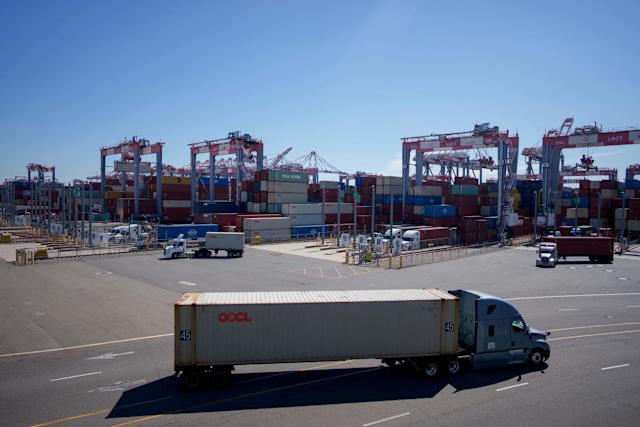
Earnings season begins: Pay attention to all the tariff talk originally appeared on TheStreet.
Updated: 11:15 EDT, Sunday
The second-quarter earnings season is upon us: six weeks to eight weeks of numbers, not to mention company officials gloating or trying to defend their results against angry investors and analysts.
This earning season, like the first-quarter season, will come with a big wildcard: President Donald Trump's efforts to impose much heavier tariffs on imports to the United States.
💵💰Don't miss the move: Subscribe to TheStreet's free daily newsletter💰💵
The Administration announced a huge list of tariffs increases on April 2 that shocked so many from the Federal Reserve to Wall Street that the Standard & Poor's 500 Index fell more than 10% over the next two days.
Related: Analyst reboots Amazon stock price target on AI growth
Here comes Tariffs, Part II
The president has proposed 35% tariffs on Canadian goods. And a 50% tariff on Brazil, the world's largest coffee producer (among other things) unless the Brazil halts prosecution of former Brazilian president Jair Bolsonaro, charging him with organizing a conspiracy to overturn Brazil's 2022 election.
Over the weekend, Trump threatened 30% tariffs on Mexico and the European Union to take effect on Aug. 1 unless they come to a new deal.
Related: Wall Street giant shares bold message on S&P 500's Magnificent 7
Sunday, some investors made it known how they feel about big tariffs: They're pushing stocks lower in futures trading.
Futures in the Dow Jones Industrial Average were down 200 points of 0.5%. S&P 500 futures were also off 29 points or about 0.5%. Nasdaq-100 futures had slid 0.4% or 97 points.
Levels in futures (contracts to buy a basket of stock for delivery later) don't correspond directly to the live market. They offer, however, a directional view of where the market may be headed. At least until the regular market opens.
In the last few months, in fact, futures trading late on Sundays has signaled weak opens for U.S. stocks on many mornings, but retail investors come in and push stocks higher.
A dangerous game
Tariffs are a dangerous game. You hear many Wall Streeters predicting the actual tariffs come in at roughly 10%.
Trump learned a small lesson in April when stocks literally started to melt down. The history of draconian tariffs is they usually cause economic mayhem. And the politicians who get them enacted or their parties lose their jobs.
So, in the meantime, the earnings start to come in: 103 in the week ahead and 702 in the week following.
Story ContinuesFinancial stocks are the week's big reports
This week's reports are heavily weighted to financial institutions and big ones, too:
-
JPMorgan Chase (JPM) , Wells Fargo (WFC) , BlackRock (BLK) and Citigroup (C) on Tuesday.
-
Bank of America (BAC) , Morgan Stanley (MS) and Goldman Sachs (GS) on Wednesday.
-
American Express (AXP) and Charles Schwab (SCHW) on Friday.
In all, some 42 financial companies will release reports this week. JPMorgan is the largest with a market cap of $797 billion. Among financial companies, only Berkshire Hathaway (BRK.A) and (BRK.B) is bigger at just over $1 trillion in market cap.
(Yes, it's true Warren Buffett's conglomerate also includes one of the biggest railroads, See's Candies and a network of truck stops, but half the business is insurance. Berkshire is expected to report results in early August.)
It's not all financial companies that report this week. Others include:
-
United Airlines (UAL) on Wednesday.
-
Taiwan Semiconductor (TSM) , Netflix (NFLX) and PepsiCo (PEP) on Thursday.
-
3M Company (MMM) and Schlumberger (SLB) on Friday.
Related: Stock Market Today: 35% Tariff on Canada Spooks Investors
Financial institutions are always trying to balance interest on loans and earnings on investments against costs, especially cost of funds or, in the case of insurance companies, the costs of paying claims.
The base short-term rate is the Fed's federal funds rate, now 4.25% to 4.5%. The Fed has been reluctant to cut rates this year because it's been concerned with how inflationary the tariffs will prove.
How the financials have fared
The 73 financial stocks in the S&P 500 financial sector in the aggregate have had a decent year. The financial sector index is up 7.9% in 2025, with 48 stocks showing positive gains for the year to date. The return ranks the financials sixth out of the 11 S&P 500 sectors.
Tops are the industrial and information technology sectors, up about 14% and 9.4%, respectively.
The financial sector fell nearly 16% between April 2, when President announced his tariff proposal and the bottom of 702.44 on April 7. Since the bottom, the sector has rebounded about 24% to 868.31.
The results are skewed a bit by Coinbase (COIN) , which runs one of the world's largest crypto currency exchanges. It's up 56% year to date. The company reports second-quarter earnings on July 31.
More Investing:
-
Weekly Wins: 10 Rules for You to Be a Winner
-
Amazon tries to make AI great again (or maybe for the first time)
-
Veteran portfolio manager raises eyebrows with latest Meta Platforms move
-
Google plans major AI shift after Meta’s surprising $14 billion move
The big banks have not been scofflaws. Charles Schwab is up 22.3% year-to-date, second best in the sector. Citigroup has risen 23%. JP Morgan has added 19.7%. Goldman Sachs' gain is 23%.
Related: Watch out: The threats that could derail the big rally
Property-and-casualty insurance companies have struggled a bit this year, especially those exposed to the Los Angeles-area wild fires earlier this year. Chubb (CB) , Allstate (ALL) and Travelers (TRV) have seen their stocks show handsome returns over the last 52 weeks.
But their returns for the year-to-date are flat or modest because of the fires. A study from UCLA estimated that the Los Angeles fires caused losses of between $95 billion and $164 billion with insured losses of some $75 billion.
What will make financial stocks buys?
Wall Street is betting President Trump's big tax bill will unleash all sorts of money into the financial markets.
That's why the S&P 500 and Nasdaq hit new highs this past week and Nvidia saw its market cap top $4 trillion. But forgotten in that euphoria was that financials were the weakest S&P 500 sector, down 1.9%.
The bill, however, is so complicated that no one is sure what's in it, much less if the provisions will do any good. The banks and other financial companies will be getting looser regulations, true. But there's risk to that: Bad or just plain stupid actors can destabilize the system.
Perhaps we should agree that a few signals would help.
The economy has to demonstrate there's a clear, stable path forward. The Administration has to demonstrate clarity of vision. You don't want constant disruptions from tariffs or other political machinations.
If the first condition is met, inflation can ease, and interest rates can come down. As important, companies will start to feel confident enough to expand new plants and offices and hire more people.
Investment flows would migrate to opportunities that offer new growth.
Related: Veteran analyst drops new clue on Nvidia’s next big move
Earnings season begins: Pay attention to all the tariff talk first appeared on TheStreet on Jul 13, 2025
This story was originally reported by TheStreet on Jul 13, 2025, where it first appeared.













